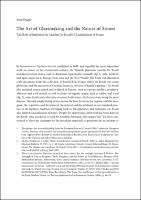Chapter The Art of Glassmaking and the Nature of Stones. The Role of Imitation in Anselm De Boodt’s Classification of Stones
| dc.contributor.author | Dupré, Sven | |
| dc.contributor.editor | Augart, Isabella | |
| dc.contributor.editor | Saß, Maurice | |
| dc.contributor.editor | Wenderholm, Iris | |
| dc.date.accessioned | 2022-04-05T12:46:28Z | |
| dc.date.available | 2022-04-05T12:46:28Z | |
| dc.date.issued | 2018 | |
| dc.identifier | ONIX_20220405_9783110583618_11 | |
| dc.identifier.issn | 2367-1955 | |
| dc.identifier.uri | https://library.oapen.org/handle/20.500.12657/53739 | |
| dc.language | German | |
| dc.language | English | |
| dc.relation.ispartofseries | Naturbilder / Images of Nature | |
| dc.subject.classification | thema EDItEUR::A The Arts::AB The arts: general topics | en_US |
| dc.subject.classification | thema EDItEUR::A The Arts::AG The Arts: treatments and subjects::AGA History of art | en_US |
| dc.subject.other | Art | |
| dc.subject.other | Stone | |
| dc.subject.other | Artistic material | |
| dc.subject.other | Nature imitation | |
| dc.title | Chapter The Art of Glassmaking and the Nature of Stones. The Role of Imitation in Anselm De Boodt’s Classification of Stones | |
| dc.type | chapter | |
| oapen.abstract.otherlanguage | What is a stone? in Gemmarum et lapidum historia (The History of Gems and Stones), pub-lished in 1609, and arguably the most important work on stones of the seventeenth cen-tury, the flemish physician anselm de Boodt listed precious stone brought to europe from asia and the new World, illustrated with specimens from the collection of rudolf iiin Prague where de Boodt was court physician, and the successor of Carolus Clusius as overseer of rudolf ’s gardens. de Boodt also included stones mined and sculpted in europe, such as various marbles, porphyry, alabaster and rock crystal, as well as stone of organic origin, such as amber and coral, fossils and a diversity of animal body stones, the bezoar stone being the most famous one. making the provenance of stones more difficult to judge, global trade made the issue of fake stones only more pressing. Since precious stones were expensive, there had been a constant concern with fake imitation stones across europe since (at least) the thirteenth century. in the first part of the book after the descrip-tion of the accidents of the stones, de Boodt indicates that this is useful knowledge because it serves to distinguish real from counterfeited stones – a purpose of the book which was highlighted in the titles of the later frensh translation of de Boodt in the 1640s as well as in the lapidary of the Cambridge scholar thomas nichols in english, which was derivative of de Boodt’s The History of Gems and Stones. this paper shows that the response to the question of “what is a stone” was defined by the use, transformation and imitation of materials, sculptors, jewellers and goldsmiths as much as by the categories and concepts of aristotelian natural philosophy and history. it will be argued that artisanal and mer-cantile knowledge of stones, focused on their physical qualities, such as the behaviour of the stone when cutting it, or the size as the most important element in determining the value of a stone in commercial exchange, underlies de Boodt’s classification of stones. | |
| oapen.identifier.doi | 10.1515/9783110583618-012 | |
| oapen.relation.isPublishedBy | 2b386f62-fc18-4108-bcf1-ade3ed4cf2f3 | |
| oapen.relation.isFundedBy | 178e65b9-dd53-4922-b85c-0aaa74fce079 | |
| oapen.relation.isbn | 9783110583618 | |
| oapen.relation.isbn | 9783110581997 | |
| oapen.relation.isbn | 9783110582062 | |
| oapen.collection | European Research Council (ERC) | |
| oapen.imprint | De Gruyter | |
| oapen.series.number | 8 | |
| oapen.pages | 14 | |
| oapen.place.publication | Berlin/Boston | |
| oapen.grant.number | 648718 | |
| oapen.grant.acronym | ARTECHNE | |
| oapen.grant.project | Technique in the Arts. Concepts, Practices, Expertise (1500-1950) |

